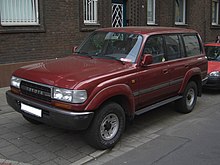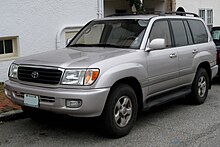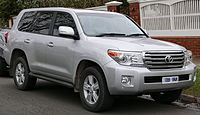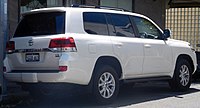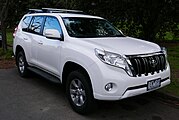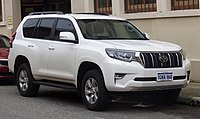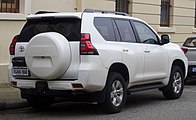Toyota Land Cruiser
| Toyota Land Cruiser | |
|---|---|
| Production period: | since 1951 |
| Class : | Off-road vehicle |
| Body versions : | Station wagon , pick-up |
The Toyota Land Cruiser is an off - road vehicle built since 1951 . This Japanese car quickly gained a reputation for reliability and durability, primarily in Africa , Latin America and the Arab world .
The vehicle was produced in different versions over the years. The Toyota Land Cruiser, together with the Toyota Hilux, is the first motor vehicle that has reached the North Pole with major modifications to the chassis, wheels and engine, among other things .
In Germany , two models are currently available, the J15, in Germany just Landcruiser (in Austria Land Cruiser 300, in the rest of the world Land Cruiser Prado or Prado ) called (since 2009) and the J20, in Germany as a Land Cruiser V8 known (2008-2015). Abroad, this version is sometimes called the Land Cruiser 200 . In addition, the J7 will continue to be produced after a facelift in 2007, primarily for Africa and Australia.
Model code
The model code consists of the letter J (for off-road vehicle) and a number for the vehicle generation. In addition, there are one or two letters for the engine code before the J and a number for the variant after the model number. For example, with the designation KDJ120, the KD stands for the 1KD-FTV engine (4 cylinders, 3 liter displacement), J12 for the model and 0 for the long model. Accordingly, KDJ125 would be the same model with the same engine, only in a short version.
Model history
Right from the start there were always two Land Cruiser models built in parallel.
The smaller models were or are sold under the names J2, J4, J7, J9, J12 and currently J15. The larger models are named J3, J5, J6, J8, J10 and currently J20.
prehistory
In 1941 the Japanese Imperial Army occupied the Philippines, where they captured a Bantam Mk II and brought it to Japan. The Japanese military authorities ordered Toyota to build a similar vehicle, but not to resemble the American Jeep. The prototype AK was called "Type 4 Small Truck" ( Japanese 四 式 小型 貨物 車 yon-shiki kogata kamotsusha ) by the Japanese army .
Later in 1941, the Japanese government asked Toyota to produce a light truck for Japanese military operations. Toyota then produced the 1/2-ton prototype AK10 in 1942. The AK10 was built using reverse engineering from the Bantam GP. There are no known surviving photographs of the AK10. The only known pictorial representations are a few sketches. It had an upright grille, flat front fenders that sloped down and back like the FJ40, headlights mounted on the fenders on either side of the radiator, and a hinged windshield.
The AK10 has a 2259 cc 4-cylinder type C engine from the Toyota Model AE Sedan with a three-speed manual transmission and a reduction gear. There is no mechanical relationship between the AK10 and the post-war Toyota "Jeep" BJ. Most of the AK10, unlike the US Jeep, were not actively used and there are almost no photos of him on the battlefield.
Beginnings after the war (BJ and FJ)
In 1950, Toyota began working on the prototype of an off-road vehicle that was manufactured in 1951 as the "BJ" on the occasion of an armaments tender by the Japanese military "National Police Reserve" (forerunner of the Japanese armed forces ). Since Toyota did not win the tender, the BJ was only used by Japanese authorities, forest administrations and the American military stationed in Japan. The original BJ was powered by a diesel engine with 3.4 l displacement and 63 kW. Equipped with leaf springs, a rigid axle and large 16-inch wheels, the BJ came onto the market less comfortable than robust. 298 units were produced to order, only four copies were exported.
J2 and J3 (1954–1967)
In 1954 the BJ was renamed Land Cruiser and made its international debut. For export it should look more civil than the BJ. The distinctive headlights of the J2 types were already integrated into the body and no longer free-standing on the fenders. It also had a more stylish body and better handling thanks to longer springs with four layers of springs. In addition, in 1956 Toyota replaced the type B diesel engine with 85 hp with a more powerful 3.9-liter six-cylinder gasoline engine with 109 hp type F. The interior became more comfortable because the engine was moved 120 mm forward. The J2 series still had no reduction, but was synchronized in third and fourth gear.
In 1957, production tripled to 2,887 units, of which only 450 remained in Japan. The Land Cruiser FJ25 officially appeared on the US market.
In addition, new body variants appeared in 1957/58, such as the first Land Cruiser Station with a longer wheelbase of 2650 mm as the FJ25 and the four-door station car under the designation FJ35V. Around half of the 1,000 third generation Land Cruisers (J3) were exported.
J4 (1960-1984)
In 1960 the J4 was introduced as the successor to the J2 and was produced until 1984. With this model, the Land Cruiser also became known in Germany from 1977.
It is available with several wheelbases and body versions , the short J40 , the rare medium-sized J43 / J46, the long J45 / J47 as a bush taxi or pick-up, the J45 as a pick-up short platform and the very rare J45 station (5-door ).
In Brazil, the vehicle was built almost unchanged as Toyota Bandeirante until 2001 under the designation OJ55. It was available with a diesel engine from Daimler-Benz . As an addition, the Bandeirante was also produced as a double cabin.
J5 (1967–1981)
The Landcruiser J5 was built from 1967. Except for a few Japanese vehicles (BJ55), the F (until 1974) and 2F (1974–1980) engines known from the J4 series were used. The exact model name is FJ55. The J5 was built primarily for North America. Technically it corresponds largely to the J4, but the body design has been changed. For the German market, Toyota had to exchange the front three-seater bench for ASS sports seats in order to comply with the applicable safety regulations. Therefore the FJ55 was only available as a 5-seater in Germany. It was produced from 1967 to 1980.
J6 (1981–1990)
The J6 introduced in 1981 replaced the J5. The vehicle was offered with both gasoline and diesel engines until 1990, whereby the gasoline engine - mostly equipped with an automatic transmission - was primarily intended for the USA.
J7 (since 1984)
In 1984, the J7 was introduced as a replacement for the J4 as a soft top and hard top (fabric top, removable fixed top), as a pick-up, as a closed three- and five-door off-road vehicle and as models with inward-facing rear seats. The J7 had rigid axles on handlebars and coil springs for better handling. The lighter version of the Land Cruiser received the Toyota 22R 2.4-liter gasoline engine, and the 2-liter and 2-liter turbo diesel and 2.4-liter diesel engines from the Toyota Hilux . In addition, a 4-liter gasoline engine was also available, which was converted to electronic direct fuel injection over the years . An automatic transmission (A440F) was also introduced.
The J7 was sold as the Toyota Bundera or Landcruiser II and later as the 70 Prado / Prado 70 in some markets . The 70 Prado was very popular and was later developed into the Prado 90.
In 1990 a new generation of diesel engines with the five-cylinder naturally aspirated engine 1PZ and the six-cylinder naturally aspirated engine 1HZ were offered.
In 1993 Toyota also introduced the 24-valve, 4.5-liter six-cylinder 1FZ petrol engine in the series.
In 1999 the J7 series was extensively revised with coil suspension instead of leaf springs on the front axle, extended rear leaf springs for increased driving comfort and spring travel. The wheels were now fixed with five instead of six wheel bolts and several minor modifications to the drive train were made to increase durability.
In 2002, the HDJ79 model was introduced, first in Australia , with the 1HD FTE 4.2 liter six cylinder 24 valve turbo diesel engine with direct injection .
Starting in 2007, Toyota built in the 4.5 liter 1VD FTV, the first V8 turbo diesel engine in the J7 series for some countries. In addition, an additional 4-door model with a medium wheelbase (76) was introduced and the front for all models was now significantly redesigned.
In 2008, production of the J7 series in Venezuela ended , while production in South Africa continued for the remaining markets.
In 2012, a double-cab pick-up was introduced in South Africa with the 4.2-liter diesel engine or 4.0-liter gasoline engine, which is also exported to Australia, but there with the 4.5-liter V8 diesel engine. In addition to Africa and Oceania , the J7 / Prado 90 generation is also officially offered in South America , countries in the Middle East and smaller Asian emerging countries from South African production.
The Land Cruiser J7 can often be seen in news programs in connection with UN missions and armed conflicts and is also approved in Germany for the purposes of the rescue service, in particular for mountain rescue.
In the field of lightweight, all-wheel drive commercial vehicles version of J7 with 6-cylinder diesel engine and manual transmission of the last series vehicles, the factory is the possibility of a power take-off has. The Land Rover Defender , which can also be retrofitted with PTO , was discontinued in early 2016.
J8 (1990-1997)
The J8 is the successor to the J6, built from 1990 to 1997. On this basis, the luxury version Lexus LX was also available for the first time . The J8 is seen as the turning point for more of everything: more luxury, especially for the European or Japanese market, and more off-road capabilities. In its successor, the J10, the rigid, coil-sprung front axle gave way to an independent suspension.
The "80s" with a 4.0 R6 petrol engine was available, which was replaced in 1992 by the 4.5 R6 1FZ-F (carburettor) or 1FZ-FE (petrol injection). The diesel engine choices were the 4.2 1HZ, the 4.2 1HD-T-12V and the 4.2 1HD-FT-24V.
In contrast to its predecessor the J6, the models of the J8 in Europe almost always had a permanent all-wheel drive.
J9 (1996-2002)
The J9, introduced in 1996, partially replaces the J7. In some countries the new model name Toyota Land Cruiser Prado is used for this. In Germany it was called Land Cruiser 90. The engine range comprised a 3.4-liter V6 petrol engine with an output of 131 kW (178 hp), as well as a 3.0-liter R4 turbo diesel, which produced 92 kW until 1999 ( 125 PS) and from August 1999 120 kW (163 PS). The engines are optionally available with a 5-speed manual gearbox or with an automatic gearbox. In 2002 the Land Cruiser 90 was discontinued.
J10 (1998-2007)
The J10 was built from 1998 to 2007 as the successor to the J8. There is also a Lexus LX for this . In Germany it was called Land Cruiser 100. The front axle is optionally available as a rigid axle (J105) or independent wheel suspension (J100). A total of two engines were available for the J10. Among the gasoline engines, the 4.7-liter V8 with 173–175 kW (235–238 hp) was the top model, the 4.2-liter R6 diesel engine developed 150 kW (204 hp), in the HZJ 105 only 96 kW (131 PS). The V8 engine is only available with an automatic transmission, the diesel engines are available with a 5-speed manual transmission or optionally with an automatic transmission. The Land Cruiser is equipped with air conditioning as standard.
J12 (2002-2009)
| Land Cruiser (J12) | |
|---|---|
|
Toyota Land Cruiser (2002-2009) |
|
| Production period: | since 2002 |
| Body versions : | Station wagon |
| Engines: |
Otto engine : 4.0 liters (183 kW) Diesel engines : 3.0 liters (120–127 kW) |
| Length: | 4365-4850 mm |
| Width: | 1790-1875 mm |
| Height: | 1850-1865 mm |
| Wheelbase : | 2455-2790 mm |
| Empty weight : | 1915-2025 kg |
The J12 replaced the J9 in 2002. It was built, often still referred to as the Toyota Land Cruiser Prado , until the end of 2009. In many countries the series is referred to as the Land Cruiser 120. There were two body versions of the Land Cruiser J12, with 3 doors or 5 doors. In Germany, a 4.0-liter V6 gasoline engine with 183 kW (249 PS) and 3.0-liter four-cylinder turbo diesel engines with 120 kW (163 PS), 127 kW (173 PS) and 130 kW (177 PS ) offered. The V6 engine is only available with an automatic gearbox, the diesel engines are available with a 5- or 6-speed manual gearbox or optionally with a 4- or 5-speed automatic gearbox.
A heavily rebuilt model in this range is one of the first cars (alongside two rebuilt Toyota Hilux ) to ever reach the Magnetic North Pole (see Top Gear: Polar Special for details ).
J20 (since 2008)
| Land Cruiser V8 (J20) | |
|---|---|
|
Toyota Land Cruiser J20 (2008-2012) |
|
| Production period: | since 2008 |
| Body versions : | Station wagon |
| Engines: |
Otto engine : 4.0–5.7 liters (202–284 kW) Diesel engine : 4.5 liters (183–210 kW) |
| Length: | 4950-5025 mm |
| Width: | 1970-1980 mm |
| Height: | 1865-1955 mm |
| Wheelbase : | 2850 mm |
| Empty weight : | 2585-2815 kg |
The fifth generation, the Land Cruiser J20, has been on the market since 2008 and replaces the predecessor J10. In this country it was called Land Cruiser V8 , in other markets it was Land Cruiser or Land Cruiser 200 . The third generation of the Lexus LX is based on it .
The Land Cruiser V8 has double wishbones on the front axle and a rigid axle at the rear. All-wheel drive and a six-speed automatic transmission are standard. For Germany there is a long-stroke V8 diesel engine with a displacement of 4.5 liters and 210 kW (286 hp) output at 3600 rpm. The maximum torque of 650 Nm is reached at 1600 to 2800 rpm. The combined consumption is 10.2 l / 100 km (270 g CO 2 emissions / km). The top speed is 210 km / h and the acceleration from 0 to 100 km / h takes 8.2 seconds.
Gasoline engines with 4.7 or 5.7 l displacement are also offered in other markets.
The Land Cruiser V8 has internally ventilated disc brakes at the front and rear. The possible payload with a gross vehicle weight of 3.3 tons is 505 to 610 kilograms, depending on the vehicle equipment. Unbraked trailers can weigh up to 750 kilograms. The trailer load braked up to a twelve percent gradient is 3.5 tons. The diesel tank holds 93 liters.
Water crossings up to 70 centimeters are possible. The gradeability is 100 percent (45 degrees), the tipping angle 44 degrees and the minimum ground clearance 225 millimeters. The Land Cruiser V8 needs 11.9 meters for a 180-degree turn.
Facelift
In spring 2012 the Land Cruiser V8 was slightly revised. Among other things, it received daytime running lights and rear lights with light-emitting diodes, and a new V8 petrol engine was introduced, but this is only available in certain markets. In Europe, only a V8 diesel will continue to be offered, which now has an output of 200 kW (272 hp).
In autumn 2015 the model received another revision, new assistance systems and minor technical changes. However, the V8 diesel does not meet the Euro 6 emissions standard , which has been mandatory since September 1, 2015 , which is why sales of the J20 on EU markets and Switzerland were discontinued with the facelift.
Technical specifications
| 4.0 V6 | 4.7 V8 | 4.6 V8 (Russia) | 5.7 V8 | 4.5 V8 D-4D | 4.5 V8 D-4D | 4.5 V8 D-4D (Russia) | |
|---|---|---|---|---|---|---|---|
| Construction period | since 03/2008 | 03/2008–12/2009 | since 01/2010 | since 03/2008 | 03/2008 - 03/2012 | 04 / 2012-09 / 2015 | since 10/2015 |
| Engine characteristics | |||||||
| Engine type | V6 petrol engine | V8 petrol engine | V8 diesel engine | ||||
| Displacement | 3956 cc | 4664 cc | 4608 cc | 5663 cc | 4461 cc | ||
| Max. Power at min −1 | 202 kW (275 PS) / 5600 | 212 kW (288 PS) / 5400 | 227 kW (309 PS) / 5500 | 284 kW (386 hp) / 5600 | 210 kW (286 PS) / 3600 | 200 kW (272 PS) / 3600 | 183 kW (249 hp) / 2800-3600 |
| Max. Torque in min -1 | 385 Nm / 4400 | 445 Nm / 3400 | 439 Nm / 3400 | 544 Nm / 3600 | 650 Nm / 1600-2800 | 650 Nm / 1600-2800 | 650 Nm / 1600-2600 |
| Power transmission | |||||||
| Drive, as standard | all wheel drive | ||||||
| Gearbox, as standard | 6-speed automatic transmission | 5-speed automatic transmission | 6-speed automatic transmission | 8-speed automatic transmission | 6-speed automatic transmission | ||
| Readings | |||||||
| Top speed | 190 km / h | 200 km / h | 205 km / h | k. A. | 210 km / h | ||
| Acceleration, 0-100 km / h | k. A. | 9.5 s | 8.6 s | k. A. | 8.2 s | 8.9 s | |
| Fuel consumption over 100 km (combined) | 15.7 l super | 14.4 l super | 13.3 l super | 15.7 l super | 10.2 l diesel | 9.5 l diesel | |
| CO 2 emissions (combined) | k. A. | 340 g / km | 308 g / km | k. A. | 270 g / km | 250 g / km | |
| Tank capacity | 93 l | ||||||
J15 (since 2009)
| J15 | |
|---|---|
|
Toyota Land Cruiser J15 (2009-2013) |
|
| Production period: | since 2009 |
| Body versions : | Station wagon |
| Engines: |
Otto engine : 2.7–4.0 liters (120–207 kW) Diesel engine : 2.8–3.0 liters (127–140 kW) |
| Length: | 4395-4840 mm |
| Width: | 1885 mm |
| Height: | 1900-1920 mm |
| Wheelbase : | 2450-2790 mm |
| Empty weight : | 2035-2495 kg |
The J15 has been built since 2009 as the successor to the J12. In Germany it bears the sales name Land Cruiser , in Austria the name Land Cruiser 300 is continued from its predecessor, in other markets as Prado or Land Cruiser Prado . The off-road vehicle is offered as a three-door and five-door body variant.
The Land Cruiser has double wishbones on the front axle and a rigid axle at the rear . All wheels are driven by a five- speed automatic transmission or a six-speed manual transmission.
Until August 2015 there was a long-stroke four-cylinder diesel engine with a displacement of three liters and an output of 140 kW (190 hp) at 3400 rpm. The maximum torque of 420 Nm is reached at 1600 to 2800 rpm. The combined consumption of the three-door model is 8 l / 100 km (210 g / km CO 2 emissions) when using the manual transmission and 8.4 l / 100 km (220 g / km) when using the automatic transmission. The five-door model consumes 0.1 l / 100 km more. The top speed is 175 km / h and acceleration from 0 to 100 km / h takes place in 11.7 seconds with the manual transmission (automatic transmission: 12.4 seconds).
The Land Cruiser has internally ventilated disc brakes at the front and rear . The possible payload with a gross vehicle weight of 2.6 tons / 2.99 tons (three-door / five-door) is 385 to 835 kilograms, depending on the vehicle equipment. Unbraked trailers can weigh up to 750 kilograms. The trailer load braked up to a twelve percent gradient is three tons. The diesel tank holds 87 liters.
Facelift
In the summer of 2013, Toyota announced a facelift. This concerns the exterior, the interior and some technical features. Among other things, the chassis has been revised, the anti-slip control has been further developed and the driving modes have been changed.
In spring 2014 the Land Cruiser will be revised again. From now on, the model has optional LED headlights with LED daytime running lights and a newly designed bumper. This makes the vehicle two centimeters longer.
Another facelift followed in August 2015 with a new engine. The new four-cylinder diesel engine has a displacement of 2755 cm³ and develops 130 kW (177 hp) at 3400 rpm and, in conjunction with a 6-speed automatic transmission, 450 Nm between 1600 and 2400 rpm. In conjunction with a 6-speed gearbox that can be manually shifted, the torque is 420 Nm between 1,400 and 2,600 rpm. Furthermore, the top speed is 175 km / h, it accelerates to 100 km / h in 12.1 seconds (automatic transmission: 12.7 seconds). The consumption of the three-door model is 7.2 l per 100 km (190 g / km CO 2 emissions) and the five-door model is 7.4 l (194 g / km).
In spring 2018, Toyota brought further innovations and improvements as part of the facelift. The bonnet was lowered in the middle, the radiator grille was redesigned and the headlights flattened. The rear lights now have LED technology as standard. In the interior, Toyota redesigned the dashboard and offers a third interior variant with the interior color beige (in addition to black and black / brown).
Technical specifications
| 2.7 VVT-i (Russia) | 4.0 VVT-i (Russia / Netherlands) | 2.8 D-4D | 3.0 D-4D | 3.0 D-4D | |
|---|---|---|---|---|---|
| Construction period | since 12/2009 | since 08/2015 | 12/2009–12/2010 | 01/2011–07/2015 | |
| Engine characteristics | |||||
| Engine type | R4 petrol engine | V6 petrol engine | R4 diesel engine | ||
| Displacement | 2694 cc | 3956 cc | 2755 cc | 2982 cc | |
| Max. Power at min −1 | 120 kW (163 hp) / 5200 | 207 kW (282 PS) / 5600 | 130 kW (177 PS) / 3400 | 127 kW (173 PS) / 3400 | 140 kW (190 PS) / 3400 |
| Max. Torque in min -1 | 248 Nm / 3800 | 387 Nm / 4400 | 420 Nm / 1400–2600 [450 Nm / 1600–3000] |
410 Nm / 1600 | 420 Nm / 1600-2800 |
| Power transmission | |||||
| Drive, as standard | all wheel drive | ||||
| Gearbox, as standard | 5-speed manual transmission | 6-speed automatic transmission | 6-speed manual transmission | ||
| Gearbox, optional | [6-speed automatic transmission] | - | [6-speed automatic transmission] | 5-speed automatic transmission | |
| Readings | |||||
| Top speed | 165 km / h [160 km / h] | 175 km / h | |||
| Acceleration, 0-100 km / h | 13.8 s [13.9 s] | 8.8 s | 12.1 s [12.7 s] | 12.4 s [11.7 s] | 11.4 s [11.0 s] |
| Fuel consumption over 100 km (combined) | 11.6 l super [11.7 l super] | 10.6 l super | 7.2–7.5 l diesel | 8.2 l diesel | 8.1 l diesel |
| CO 2 emissions (combined) | 288 g / km [292 g / km] | 248 g / km | 190-197 g / km | 217 g / km | 214 g / km |
| Tank capacity | 87 l | ||||
Technical - war effort
The Toyota Land Cruiser is often used as a so-called " technical " , especially in asymmetrical conflicts . The presence of the Land Cruiser and the Toyota Hilux in the territories occupied by the Islamic State in Iraq, Syria and Libya is so noticeable that the US Treasury Department turned to the manufacturer. The carmaker should help to clarify the question of how the Islamic State got the many vehicles.
Individual evidence
- ↑ www.off-road.com ( page no longer available , search in web archives ) Info: The link was automatically marked as defective. Please check the link according to the instructions and then remove this notice.
- ↑ Land cruiser at the mountain rescue service , www.bergwacht-bayern.org
- ↑ Archived copy ( memento of the original from July 26, 2016 in the Internet Archive ) Info: The archive link was inserted automatically and has not yet been checked. Please check the original and archive link according to the instructions and then remove this notice. Information about power take-offs J4, J6, J7
- ↑ www.4wheelfun.de
- ↑ Motor Presse Stuttgart GmbH & Co. KG (2015): Toyota Land Cruiser 200 V8 Facelift 2016 . accessed on September 27, 2015.
- ↑ www.auto-motor-und-sport.de
- ↑ Toyota (2015): New 2.8-liter four-cylinder turbodiesel for the Toyota Land Cruiser ( Memento of the original from July 2, 2015 in the Internet Archive ) Info: The archive link was inserted automatically and has not yet been checked. Please check the original and archive link according to the instructions and then remove this notice. . accessed on September 6, 2015.
- ↑ Thomas Gutschker, Boris Schmidt and Thomas Scheen: The little man's cavalry. Toyota's "pick-ups". In: Frankfurter Allgemeine Zeitung . April 11, 2011, accessed April 11, 2011 (The Toyota in Asymmetric Warfare ).
- ↑ Spiegel Online from October 7, 2015: IS vehicle fleet: Toyota's problem with the terror trucks .
literature
- Alexander Wohlfarth: Legend Land Cruiser. Heel-Verlag, updated and expanded edition 2018, ISBN 978-3958433021 .
Web links
- Official website Land Cruiser V8
- Official Land Cruiser website
- TOYOTA Land Cruiser Brand-site TOUGH IS LEGEND (Japanese)
- Deutscher Landcruiser-Club eV, the club for all Toyota off-road vehicles
- buschtaxi.de, information platform for Toyota off-road vehicles








